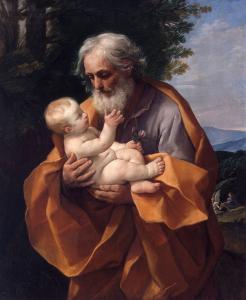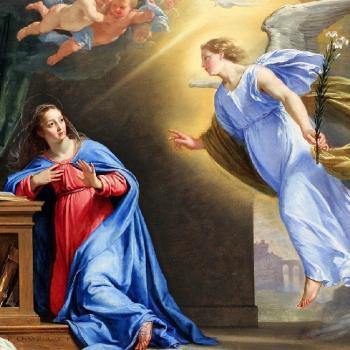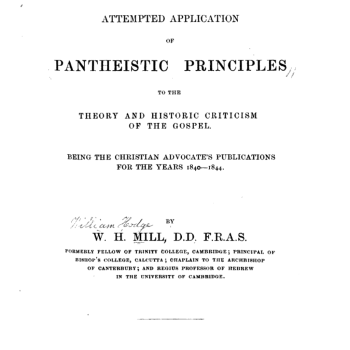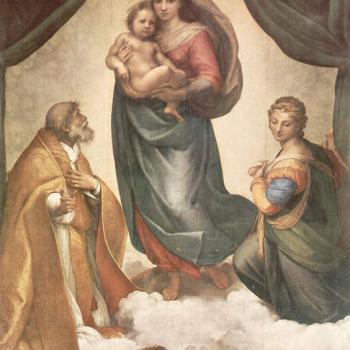Timothy F. Kauffman was raised Catholic, converted to Protestantism in 1990, and is now a Presbyterian (PCA). He has written, “I was saved out of Roman Catholicism, and into Christianity, . . . Roman Catholicism was out of accord with the Gospel of Jesus Christ.” Timothy is author of the books, Quite Contrary: Biblical Reconsiderations of the Apparitions of Mary (1994), Graven Bread: The Papacy, the Apparitions of Mary, and the Worship of the Bread of the Altar (1995), and is co-author with Robert M. Zins, of A Gospel Contrary!: A Study of Roman Catholic Abuse of History and Scripture to Propagate Error (April 24, 2023). He has been blogging about theology and Catholicism since 2014. His words will be in blue.
*****
I will be responding to the first portion of Timothy’s article, “Removing Jesus” (6-1-14).
There is only so much stooping God can do without soiling Himself beyond what He can bear. Sure, He fixed his tabernacle among His people, but God ministers at the door of the Tabernacle (Exodus 33:9), and that tabernacle is Mary. And such a tabernacle would need to be sinless.
The word “need” above — used as supposedly describing Catholic beliefs — is misguided. Catholicism teaches that Mary’s Immaculate Conception was not absolutely necessary in order for her to bear Jesus in her womb, but rather, only “fitting“. I’ve written about this several times:
Mary’s Immaculate Conception: Necessary or “Fitting”? [12-8-17]
Biblical Evidence for the Supposedly Exclusive “Catholic” Notion of “Fittingness” [Facebook, 2-2-23]
Timothy cites Ineffabilis Deus from 1854, which decreed the dogma of Mary’s Immaculate Conception. It never states that it was “necessary” for Mary to be immaculate in order to bear Jesus, or that she “needed” to be. Thus, it isn’t proof of the claim that Timothy is making, that he mistakenly thought this link would back up. Rather, it uses the word “fit” with regard to Mary’s Immaculate Conception once, and “fitting” three times. Here are all of the instances:
And indeed it was wholly fitting that so wonderful a mother should be ever resplendent with the glory of most sublime holiness and so completely free from all taint of original sin . . .
. . . she was entirely a fit habitation for Christ, not because of the state of her body, but because of her original grace.
For it was certainly not fitting that this vessel of election should be wounded by the common injuries, since she, differing so much from the others, had only nature in common with them, not sin. In fact, it was quite fitting that, as the Only-Begotten has a Father in heaven, whom the Seraphim extol as thrice holy, so he should have a Mother on earth who would never be without the splendor of holiness.
Likewise, Munificentissimus Deus, the 1950 declaration of the dogma of Mary’s Bodily Assumption, uses the word “fitting” seven times; for example, “it is fitting and right to believe the bodily Assumption of the Blessed Virgin Mary into heaven” (36).
Dictionary . com defines “fitting” (adj.) as “suitable or appropriate; proper or becoming.” Thesaurus . com provides 21 synonyms for “fitting” including “apt,” “proper,” “correct,” “desirable,” and “seemly.” None of them are “necessary.” It simply doesn’t mean that. If Jesus were to appear as He did after His resurrection to one of us at our house today, it would be altogether fitting and proper to clean up the house and offer Him a nice dinner. (just as we would act with a president or a king). But it wouldn’t be necessary.
This fact of fittingness rather than necessity pretty much undercuts Timothy’s argumentation throughout this article, because he starts with an erroneous premise as to what we dogmatically teach in the first place. It’s common misunderstanding, even among many Catholics, so he need not feel too bad.
“The womb of Mary—I will not call it womb, but temple; … the more secret tabernacle, … Yea verily above the heavens must Mary’s womb be accounted, since it sent back the Son of God to heaven more glorious than He had come down from heaven.” (St. Maximus, Homily V)
Thus, while it is true that Jesus “humbled” Himself to become man, He did not so humble Himself that He actually came down from heaven.
Huh? St. Maximus plainly states that Jesus “had come down from heaven.” But then Timothy denies that he did so? What gives? Jesus being more glorious after His incarnation is a scriptural fact:
Philippians 2:5-11 (RSV) Have this mind among yourselves, which is yours in Christ Jesus, [6] who, though he was in the form of God, did not count equality with God a thing to be grasped, [7] but emptied himself, taking the form of a servant, being born in the likeness of men. [8] And being found in human form he humbled himself and became obedient unto death, even death on a cross. [9] Therefore God has highly exalted him and bestowed on him the name which is above every name, [10] that at the name of Jesus every knee should bow, in heaven and on earth and under the earth, [11] and every tongue confess that Jesus Christ is Lord, to the glory of God the Father.
A crucial part of this, of course, is the incarnation, which required the human being Mary. And so Catholics wax eloquent about the glory and wonder involved with God using a human being in such an extraordinary way.
Except, of course, for the fact that He was raised in a perfectly sinless home. Someone as holy as Jesus could not come this far and then live in a household contaminated by the sins He had come to take away.
He certainly could have.
Therefore, Joseph must have been preserved from sin, too. The Apparition of Joseph [see updated link and another Catholic article about it] in 1956 assured Sister Mary Ephrem that “immediately after my conception … because of my exceptional role of future Virgin-Father … I was from that moment confirmed in grace and never had the slightest stain on my soul.”
Catholics, as Timothy surely knows, are not required to accept or believe any private revelations, including apparitions of this sort. That being the case, it’s incorrect for Timothy to pretend that this is the “official” teaching of the Catholic Church and one that all Catholics must (or do) accept. It may be true, and Catholics are not forbidden from believing it, but if it were true that all Catholics were bound to do so as a matter of dogma, certainly that would have been clear, and Timothy could have found such a declaration to bolster his argument, rather than a private revelation that no Catholic is obliged to accept.
In any event, if Joseph was indeed sinless, this would have been “fitting” and not “necessary” in order for Jesus to come to earth, as was the case with Mary (and this undercuts Timothy’s entire reasoning chain (“Joseph must have been preserved from sin, too,” etc.). Jesus didn’t require sinlessness at every turn, otherwise He couldn’t have preached to sinners and healed them, etc. (as Timothy correctly notes at the beginning of his article). The Catholic Church has never taught that. If it was fitting for Mary, it would have been for Joseph, too, in this event. If we consult Denzinger (43rd edition, 2012), #3260 (pp. 648-649), we have an encyclical, Quamquam pluries (“On Devotion to St. Joseph”) from 15 August 1889, from Pope Leo XIII. It doesn’t contain the words or phrases “”sinless,” or “without sin,” or “impeccable,” or “immaculate,” with regard to St. Joseph.
It does refer to “his holiness, his glory” and states that “as Joseph has been united to the Blessed Virgin by the ties of marriage, it may not be doubted that he approached nearer than any to the eminent dignity by which the Mother of God surpasses so nobly all created natures.” That’s pretty high language, and the Church may one day declare that he is sinless, but as of now it’s not dogmatic, required belief. Therefore, Timothy shouldn’t sarcastically imply that it is required Catholic belief. His readers likely won’t make these proper distinctions. He, as the researcher, ought to be the one who makes this clear. But he doesn’t. It would, after all, go against his plan of presenting the Catholic Church in the most negative light, from a Protestant perspective. This is the problem of excessive bias (in anyone). It often brings about inaccurate and inadequate research.
Except, of course, for the fact that His cousin, John the Baptist, the herald of the King, also lived a life without sin. This “acceptable belief,” as you can read here, is freely accepted as true by Roman Catholics. As one member of the Catholic Answers forum explains, “It is crystal clear from Scripture that St. John the Baptist was baptized within his mother’s womb … [and] was free of all sin from that point on.”
Again, this may be true, and the Church might one day declare it, but if so, it will be regarded as “fitting” and not necessary. That the Church has not dogmatically declared it is indicated by the source Timothy employs: a mere Catholic Answers forum participant. As far as I know, the Church has not pronounced upon this question. It’s not in Denzinger, for sure. If Timothy wants to argue for a supposed Catholic doctrine from participants in an online forum, he can do so, but it proves nothing, and is most unimpressive.
So widespread is this “pious belief,” that even Pope John XXIII in 1960 taught the logical implications of it: namely that Joseph and John the Baptist must have been assumed bodily into heaven, just as Jesus and Mary had been. “So we may piously believe,” said John XXIII, that the grace of assumption into heaven, so recently and infallibly declared for Mary in 1950, was also granted both to John the Baptist and to Joseph (Acta Apostolicae Sedis, vol. 52 (1960) 456).
In his article at EWTN, “St. Joseph: A Theological Introduction,” by Fr. Michael D. Griffin, O.C.D. stated:
On May 26, 1960 Pope John XXIII in his homily for the feast of the Ascension of Our Lord made a statement that the Assumption to Saint Joseph is worthy of pious belief (cosi piamente noi possiamo credere). He also stated that he believed the same privilege was accorded to Saint John the Baptist. This is the first time that a Pope has ever made a public statement on the subject and the fact should offer great reassurance to those who feel it would be contrary to their religious sentiments to imagine Christ refusing Joseph this crowning grace. Pope John’s words are a guarantee that such a belief is truly prudent and therefore can no longer be classified as a “pious exaggeration”. (Footnote: Text quoted by F. L. FIIAS, Joseph the Man Closest to Jesus [Boston 1962], p. 429. Cf. Acta Apost. Sedis 52 (1960) 455-456)
Again, it’s not required belief, and even this “pious” belief is very far from the claim that it was “necessary” for these things to occur in order for the incarnation to take place. Timothy is simply projecting onto Catholic belief what isn’t there.
Except, of course, the fact that all of the apostles were sinless, too. That this is “acceptable belief” in Rome is evidenced from another writer at the Catholic Answers forum, who holds that not only the apostles, but many, many Roman Catholics led perfectly sinless lives after encountering Christ:
Again, Timothy appeals to a lone commentator at the Catholic Answers forum. That’s the best he can do? He actually thinks this accomplishes anything towards proving his claim? We’re supposed to believe that the Church requires us to believe in “many, many” sinless Catholics, lest Jesus would refuse to come to earth to save sinners? If Timothy wants to make this claim that the Catholic Church actually teaches this, let him prove it from the relevant documents.
Except, of course, that His maternal grandparents must have been “profoundly pure” as well.
Remember his initial premise: that [Catholics allegedly teach that] Jesus wouldn’t and couldn’t have come to earth as the incarnate God unless everyone around Him was sinless like He was. And note the misguided word “must” above. Timothy contends that we teach that all of these things he brings up are necessary; that they “must” have happened, according to his mistaken view of what the Catholic Church teaches. We never taught such a thing. Some of these people may indeed be declared one day to be sinless, but it still won’t be the case that they “must” have been for the incarnation to proceed. And the latter is actually Timothy’s central point.
This is the argument most often heard in this regard: “if Mary was immaculate, then her mother and father had to have been, too . . .” Nope! The Immaculate Conception refers to Mary alone and has nothing whatsoever to do with anyone else. St. Joseph wasn’t required to be sinless, nor was St. Anne, nor St. Joachim: the Blessed Virgin Mary’s maternal grandparents. Once this notion of “necessity” is discarded as a non sequitur, the truth of the matter can be comprehended.
It is thus difficult for Roman Catholics to picture in their minds that Mary had been conceived through normal, biological, copulative processes, including the physical pleasure and all of the attendant physical intimacy between man and wife.
Really? I never heard that. I’ve been a Catholic almost 33 years now, and a professional Catholic apologist for more than 21 years. This is simply the old prejudiced saw that Catholics must always be against sex itself, or at any rate, against pleasure in sex. The dogma of the Immaculate Conception doesn’t deny that Mary’s existence came about in the usual manner. She was conceived and then God did a supernatural act of grace.
Timothy’s evidence here is one portion of a lecture by Christopher West on the theology of the body. I’m not sure it supports at all his contention (West does, after all, refer to “the marriage bed”; cf. Heb 13:4: clearly a sexual reference). It certainly doesn’t prove that “Roman Catholics” en masse labor under the delusion that Timothy groundlessly attributes to them.
It is apparently inconceivable to Mr. West that Mary might have been conceived in an intimate sexual embrace, her parents lying down in bed, naked, enjoying the sheer physical pleasure that, as Paul wrote, was the “proper gift of God” to each of them (1 Corinthians 7:7). No, their hearts had to be “profoundly pure,” and that level of purity does not countenance the horizontality of unashamedly pleasurable marital sex.
I’m not gonna go listen to this whole lecture, but in the portion transcribed, I don’t see that West denied the pleasure in the sexual act (including “horizontality”) that led to Mary’s conception. If he did elsewhere in the lecture, then let Timothy document it (instead of, in effect, requiring that his readers do so). But even if West did claim this or hold the view, it would be absurd to generalize his one opinion to all Catholics. Moreover, to prove that this was some “official” teaching, Timothy would be obliged to cite those sorts of sources. So he’s still a universe away from establishing his central contention. Timothy is much more a master at describing sex acts than he is in accurately conveying Catholic teachings.
The point we are making is that Jesus was incarnated to save sinners, yet Rome has built up a religion that is intent on saving Jesus from the sinners He came to save! We see this in the march of Roman Catholic tradition that is constantly expanding the circle of sinlessness that surrounds this Man who, so we thought, had come to dine with sinners, touch lepers and be worshiped by prostitutes.
And that point has been refuted over and over.
Is it unfathomable that Jesus, Who freely and deliberately dined and lodged with sinners, might have taken up His first residence in one, and received His first meal from one?
No; by the very fact that we have held that Mary’s Immaculate Conception was not necessary, but only fitting. Therefore, it’s fathomable that Mary could have possibly not been sinless in some theoretical imaginable scenario.
Is it unfathomable that Jesus, Who left Heaven to find sinners might have included among them a mother, a step-father, a cousin and two grandparents who were as eager to be cleansed of their sin as the harlots and lepers?
No; it’s possible that all of these besides Mary, committed sins, according to Catholic doctrine.
To Roman Catholics, the answer is yes—it is unfathomable. So far removed is Jesus from sinners in the religion of Rome, that to approach Him to be cleansed, one must already be clean.
That’s sheer nonsense, as shown.
***
***
Photo credit: Saint Joseph with the Infant Jesus (c. 1635). by Guido Reni (1575-1642) [public domain / Wikimedia Commons]
Summary: Presbyterian Timothy Kauffman says St. Joseph, St. John the Baptist, St. Anne, & others close to Jesus MUST have been sinless, according to Catholic teaching. Wrong!














